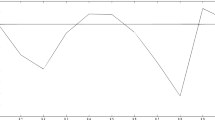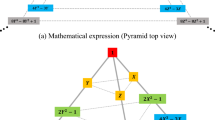Abstract
In this paper, an r-dimensional reduced-order model (ROM) for infinite-dimensional delay differential equations (DDEs) is developed. The eigenvalues of the ROM match the r rightmost characteristic roots of the DDE with a user-specified tolerance of \(\varepsilon \). Initially, the DDE is approximated by an N-dimensional set of ordinary differential equations using Galerkin approximations. However, only \(N_{c}\)\((< N)\) eigenvalues of this N-dimensional model match (with a tolerance of \(\varepsilon \)) the rightmost characteristic roots of the DDEs. By performing numerical simulations, an empirical relationship for \(N_{c}\) is obtained as a function of N and \(\varepsilon \) for a scalar DDE with multiple delays. Using eigenvalue decomposition, an r\((= N_{c})\) dimensional model is constructed. First, an appropriate r is chosen, and then the minimum value of N at which at least r roots converge is selected. For each of the test cases considered, the time and frequency responses of the original DDE obtained using direct numerical simulations are compared with the corresponding r- and N-dimensional systems. By judiciously selecting r, solutions of the ROM and DDE match closely. Next, an r-dimensional model is developed for an experimental 3D hovercraft in the presence of delay. The time responses of the r-dimensional model compared favorably with the experimental results.
























Similar content being viewed by others
References
Chakraborty S, Kandala SS, Vyasarayani CP (2018) Reduced ordered modelling of time delay systems using Galerkin approximations and eigenvalue decomposition. IFAC-PapersOnLine 51(1):566–571
Thomson W (1949) Delay networks having maximally flat frequency characteristics. Proc IEE-Part III: Radio Commun Eng 96(44):487–490
Storch L (1954) Synthesis of constant-time-delay ladder networks using Bessel polynomials. Proc IRE 42(11):1666–1675
Glader C, Hognas G, Makila P, Toivonen H (1991) Approximation of delay systems-a case study. Int J Control 53(2):369–390
Gu G, Khargonekar PP, Lee EB (1989) Approximation of infinite-dimensional systems. IEEE Trans Automat Contr 34(6):610–618
Lam J (1990) Convergence of a class of Padé approximations for delay systems. Int J Control 52(4):989–1008
Lam J (1993) Model reduction of delay systems using Padé approximants. Int J Control 57(2):377–391
Mäkilä PM (1990) Approximation of stable systems by Laguerre filters. Automatica 26(2):333–345
Mäkilä PM (1990) Laguerre series approximation of infinite dimensional systems. Automatica 26(6):985–995
Partington JR (1991) Approximation of delay systems by Fourier-Laguerre series. Automatica 27(3):569–572
Lam J (1994) Analysis on the Laguerre formula for approximating delay systems. IEEE Trans Automat Contr 39(7):1517–1521
Yoon M, Lee B (1997) A new approximation method for time-delay systems. IEEE Trans Automat Contr 42(7):1008–1012
Mäkilä PM, Partington JR (1999) Laguerre and Kautz shift approximations of delay systems. Int J Contr 72(10):932–946
Mäkilä PM, Partington JR (1999) Shift operator induced approximations of delay systems. SIAM J Control Optim 37(6):1897–1912
Harkort C, Deutscher J (2011) Krylov subspace methods for linear infinite-dimensional systems. IEEE Trans Automat Contr 56(2):441–447
Michiels W, Jarlebring E, Meerbergen K (2011) Krylov-based model order reduction of time-delay systems. SIAM J Matrix Anal Appl 32(4):1399–1421
Michiels W, Jarlebring E, Meerbergen K (2011) A projection approach for model reduction of large-scale time-delay systems, with application to a boundary controlled PDE. In: 50th conference on decision and control and European control conference. IEEE, pp 3482–3489
Michiels W, Hilhorst G, Pipeleers G, Swevers J (2016) Model order reduction for time-delay systems, with application to fixed-order \(h_{2}\) optimal controller design. In: Recent results on time-delay systems. Springer, pp 45–66
Rommes J, Martins N (2006) Efficient computation of multivariable transfer function dominant poles using subspace acceleration. IEEE Trans Power Syst 21(4):1471
Rommes J, Martins N (2006) Efficient computation of transfer function dominant poles using subspace acceleration. IEEE Trans Power Syst 21(3):1218–1226
Rommes J, Martins N (2008) Computing transfer function dominant poles of large-scale second-order dynamical systems. SIAM J Sci Comput 30(4):2137–2157
Rommes J, Sleijpen GL (2008) Convergence of the dominant pole algorithm and Rayleigh quotient iteration. SIAM J Matrix Anal Appl 30(1):346–363
Saadvandi M, Meerbergen K, Jarlebring E (2012) On dominant poles and model reduction of second order time-delay systems. Appl Numer Math 62(1):21–34
Zhang Y, Su Y (2013) A memory-efficient model order reduction for time-delay systems. BIT Numer Math 53(4):1047–1073
Cullum J, Zhang T (2002) Two-sided Arnoldi and nonsymmetric Lanczos algorithms. SIAM J Matrix Anal Appl 24(2):303–319
Wang Q, Wang Y, Lam EY, Wong N (2013) Model order reduction for neutral systems by moment matching. Circuits Syst Signal Process 32(3):1039–1063
Scarciotti G, Astolfi A (2016) Model reduction of neutral linear and nonlinear time-invariant time-delay systems with discrete and distributed delays. IEEE Trans Automat Contr 61(6):1438–1451
Wahi P, Chatterjee A (2005) Galerkin projections for delay differential equations. J Dyn Syst Meas Contr 127(1):80–87
de Jesus Kozakevicius A, Kalmár-Nagy T (2010) Weak formulation for delay equations. In: 9th Brazilian conference on dynamics, control and their applications
Vyasarayani CP (2012) Galerkin approximations for higher order delay differential equations. J Comput Nonlinear Dyn 7(3):031004
Vyasarayani CP, Subhash S, Kalmár-Nagy T (2014) Spectral approximations for characteristic roots of delay differential equations. Int J Dyn Contr 2(2):126–132
Radke RJ (1996) A Matlab implementation of the implicitly restarted Arnoldi method for solving large-scale eigenvalue problems. Ph.D. thesis, Rice University
Michiels W, Engelborghs K, Vansevenant P, Roose D (2002) Continuous pole placement for delay equations. Automatica 38(5):747–761
Lehotzky D, Insperger T (2016) A pseudospectral tau approximation for time delay systems and its comparison with other weighted-residual-type methods. Int J Numer Methods Eng 108(6):588–613
Ahsan Z, Uchida TK, Vyasarayani CP (2015) Galerkin approximations with embedded boundary conditions for retarded delay differential equations. Math Comput Model Dyn Syst 21(6):560–572
Heizer B, Kalmár-Nagy T (2018) Proper orthogonal decomposition and dynamic mode decomposition of delay-differential equations. IFAC-PapersOnLine 51(14):254–258
Vyhlídal T, Zítek P (2014) QPmR-Quasi-polynomial root-finder: algorithm update and examples. In: Delay systems. Springer, pp 299–312
Michiels W, Hilhorst G, Pipeleers G, Vyhlídal T, Swevers J (2017) Reduced modelling and fixed-order control of delay systems applied to a heat exchanger. IET Control Theory Appl 11(18):3341–3352
Apkarian J, Lévis M (2013) Laboratory guide, 3 DOF Hover experiment for Matlab/Simulink users. Quanser Inc
Acknowledgements
CPV gratefully acknowledges the Department of Science and Technology for funding this research through the Inspire fellowship (DST/INSPIRE/04/2014/000972). We thank Dr. Ketan P. Detroja for providing laboratory working space for the 3D hovercraft used in Section 5 The authors thank K. Subhash Babu for assistance in performing the experiments.
Author information
Authors and Affiliations
Contributions
CPV conceived the idea. SC and SSK generated the results and conducted the experiments. All the authors equally contributed to writing the manuscript.
Corresponding author
Additional information
A preliminary version of this paper was presented at the 5th IFAC Conference on Advances in Control and Optimization of Dynamical Systems, Hyderabad, India, 2018 [1].
Rights and permissions
About this article
Cite this article
Chakraborty, S., Kandala, S.S. & Vyasarayani, C.P. Reduced ordered modelling of time delay systems using galerkin approximations and eigenvalue decomposition. Int. J. Dynam. Control 7, 1065–1083 (2019). https://doi.org/10.1007/s40435-019-00510-3
Received:
Revised:
Accepted:
Published:
Issue Date:
DOI: https://doi.org/10.1007/s40435-019-00510-3




